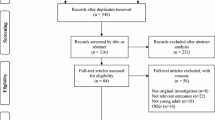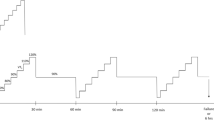Summary
Highly trained athletes (HT) have been found to show arterial hypoxaemia during strenuous exercise. A lack of compensatory hyperpnoea and/or a limitation of pulmonary diffusion by pulmonary interstitial oedema have been suggested as causes, but the exact role of each is not clear. It is known, however, that interstitial pulmonary oedema may result in rapid shallow breathing (RSB). The purpose of this study was therefore twofold: firstly, to determine the exact role of a lack of compensatory hyperpnoea versus a widened in ideal alveolar minus arterial oxygen partial pressure difference [P A(i)-aO2] in the decrease in partial pressure of oxygen in arterial blood (P aO2) and, secondly, to detect RSB during recovery in HT. Untrained subjects (UT) and HT performed exhausting incremental exercise. During rest, exercise testing, and recovery, breathing pattern, respiratory gas exchange, and arterial blood gases were measured. The P A(i)-aO2 and the difference in tidal volume (V T) between exercise and recovery for the same level of ventilation, normalized to vital capacity of the subject [ΔV T(%VC)], were then calculated. A large positive ΔV T (%VC) was considered to be the sign of RSB. HT showed a marked hypoxaemia (F=11.6, P < 0.0001), higher partial pressure of carbon dioxide in arterial blood (F= 3.51, P < 0.05), and lower ideal partial pressure of oxygen in alveolar gas (P < 0.001). The relationship between P A(i)-aO2 and oxygen consumption was the same for the two groups. The widening P A(i)-aO2 persisted throughout recovery for both HT and UT. The RSB was observed in HT during recovery. These results would suggest that the lack of compensatory hyperpnoea in HT during submaximal exercise was the major factor in the decrease in P aO2. The RSB and the widening P A(i)-aO2 during recovery would suggest that interstitial pulmonary oedema was involved during the strenuous exercise in the case of HT. Lastly, the wide P A(i)-aO2 observed in UT during recovery would suggest that an increase in extravascular pulmonary water may also have been involved for these subjects, although to a lesser extent.
Similar content being viewed by others
References
Casaburi R, Storer TW, Wasserman K (1987) Mediation of reduced ventilatory response to exercise after endurance training. J Appl Physiol 63:1533–1538
Chwalbinska-Moneta J, Hänninen O (1989) Effect of active warming-up on thermoregulatory, circulatory, and metabolic responses to incremental exercise in endurance-trained athletes. Int J Sports Med 10:25–29
Clark JM, Sinclair RD, Lenox JB (1980) Chemical and nonchemical components of ventilation during hypercapnic exercise in man. J Appl Physiol 48:1065–1076
Coates GH, O'Brodovich H, Jefferies AL (1983) The effect of exercise on lung fluid and protein exchange in sheep (abstract). Am Rev Respir Dis 127 (part 2):305
Cook GC, Mead GL, Schreiner GL, Frank NR, Craig JM (1959) Pulmonary mechanics during induced pulmonary oedema in anesthetised dogs. J Appl Physiol 14:177–186
Cumming G, Jones JG, Horsfield K (1969) Inhaled argon boluses. J Appl Physiol 27:447–451
Dempsey JA (1986) Is the lung built for exercise? Med Sci Sports Exerc 18:143–155
Dempsey JA, Fregosi RF (1985) Adaptability of the pulmonary system to changing metabolic requirements. Am J Cardiol 55:59D-67D
Dempsey JA, Hanson P, Pegelow D, Claremont A, Rankin J (1982) Limitation to exercise capacity and endurance: pulmonary system. Can J Appl Sport Sci 7:4–13
Dempsey JA, Hanson PG, Henderson KS (1984) Exercise-induced arterial hypoxaemia in healthy human subjects at sea level. J Physiol 355:161–175
Gallagher CG, Younes M (1986) Breathing pattern during and after maximal exercise in patients with chronic obstructive lung disease, interstitial lung disease and cardiac disease, and in normal subjects. Am Rev Respir Dis 133:581–586
Gallagher CG, Im Hof V, Younes M (1985) Effect of inspiratory muscle fatigue on breathing pattern. J Appl Physiol 59:1152–1158
Goresky CA, Cronin RF, Wangel BE (1969) Indicator dilution measurements of extravascular water in the lung. J Clin Invest 48:487–501
Guyton AC, Lindsey AW (1959) Effect of elevated left atrial pressure and decreased plasma protein concentration on the development of pulmonary oedema. Circ Res 7:649–657
Hammond MD, Gale GE, Kapitan KS, Ries A, Wagner PD (1986) Pulmonary gas exchange in humans during exercise at sea level. J Appl Physiol 60:1590–1598
Holmgren A, McIlroy MB (1964) Effect of body temperature on arterial blood gas tensions and pH during exercise. J Appl Physiol 19:243–245
Hopkins SR, McKenzie DC (1989) Hypoxic ventilatory response and arterial desaturation during strenuous work. J Appl Physiol 67:1119–1124
Koyal SN, Whipp BJ, Huntsman D, Bray GA, Wasserman K (1976) Ventilatory responses to metabolic acidosis of treadmill and cycle ergometry. J Appl Physiol 40:864–867
Levine OR, Mellins RB, Fishman AP (1965) Quantitative assessment of pulmonary oedema. Circ Res 17:414–426
Mador MJ, Acevedo FA (1991) Effect of respiratory muscle fatigue on breathing pattern during incremental exercise. Am Rev Respir Dis 143:462–468
Mahler D, Moritz E, Loke J (1982) Ventilatory responses at rest and during exercise in marathon runners. J Appl Physiol 52:388–392
Marshall BE, Teichneir RL, Kallos T, Sugerman HJ, Wyche MQ, Tantum KR (1971) Effects of posture and exercise on the pulmonary extravascular water volume in man. J Appl Physiol 31:375–379
Martin BJ, Weil JV (1979) CO2 and exercise tidal volume. J Appl Physiol 46:322–325
Paintal AS (1973) Vagal sensory receptors and their reflex effects. Physiol Rev 53:159–227
Poon C, Greene JG (1985) Control of exercise hyperpnea during hypercapnic in humans. J Appl Physiol 59:792–797
Powers SK, Dodd S, Lawler J, Landry G, Kirtley M, McKnight T, Grinton S (1988) Incidence of exercise induced hypoxaemia in elite endurance athletes at sea level. Eur J Appl Physiol 58:298–302
Torre-Bueno JR, Wagner PD, Saltzman HA, Gale GE, Moon RE (1985) Diffusion limitation in normal humans during exercise at sea level and simulated altitude. J Appl Physiol 58:989–995
Wagner PD, Gale GE, Moon RE, Tore-Bueno JR, Stolp BW, Saltzman HA (1986) Pulmonary gas exchange in humans exercising at sea level and simulated altitude. J Appl Physiol 61:260–270
Warren GL, Cureton KJ, Middendorf WF, Ray CA, Warren JA (1991) Red blood cell pulmonary capillary transit time during exercise in athletes. Med Sci Sports Exerc 23:1353–1361
Whipp BJ, Pardy L (1986) Breathing during exercise. In: Fishman AP (ed) Handbook of physiology; the respiratory system, mechanism of breathing, section 3, 2. American Physiological Society, Bethesda, pp 605–629
Williams JH, Powers SK, Stuart MK (1986) Hemoglobin desaturation in highly trained athletes during heavy exercise. Med Sci Sports Exerc 18:168–173
Winner BJ (1971) Statistical principles in experimental Design. McGraw-Hill, New York
Younes M, Burks J (1985) Breathing pattern during and after exercise of different intensities. J Appl Physiol 59:898–908
Author information
Authors and Affiliations
Rights and permissions
About this article
Cite this article
Caillaud, C., Anselme, F., Mercier, J. et al. Pulmonary gas exchange and breathing pattern during and after exercise in highly trained athletes. Europ. J. Appl. Physiol. 67, 431–437 (1993). https://doi.org/10.1007/BF00376460
Accepted:
Issue Date:
DOI: https://doi.org/10.1007/BF00376460




